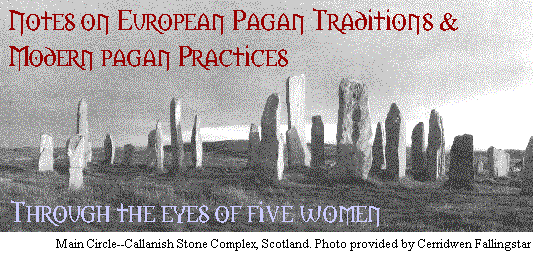

Sharon Folsom, Fort Bragg
The
name "Celt" actually comes from the Keltoi tribe of northern Macedonia
from around 500 B.C. At the time of the Roman Empire, the British Isles
and what is today France, Spain, northern Italy, large sections of Germany
and parts of Denmark were Celtic-speaking. Surviving Celtic languages are
Brethonic Celtic--including Welsh and Breton, and Gaelic Celtic--Scotish
and Irish. Not long ago, the Irish spoke Gaelic or were bilingual since
Gaelic was deliberately suppressed. My great-grandparents were Gaelic speakers.
During the ancient period, before the introduction of
Christianity, the indigenous religion of the Celts had a priesthood. Who
really knows what they called themselves? They were called "druids" by
the Romans--a word meaning "people associated with oak trees." The sacred
groves were their churches. Julius Caesar, after his conquest of France,
wrote a book called
The Gallic Wars since that part of Europe was
called "Gaul." This book was Caesar's political justification for trying
to save the savages from themselves. He talked about horrific things that
druids did, but there is not a scrap of evidence to support this. A lot
of what we've heard about them is a Victorian invention based on this document
by Caesar. For intelligent reading about that priesthood, based on surviving
Welsh and Gaelic ritual, read
The White Goddess by Robert Graves.
Gaelic people, in and out of monasteries, had a rich intellectual
and artistic life. Literacy was commonplace. Their arts and crafts and
surviving literature astound us today with their almost magical technical
perfection and rich complexity. Women had a very degree of independence
and freedom. Today, our most radical feminists talk about the possibility
of a system in which women would be compensated for bearing children and
performing work in the home. That was institutionalized in Gaelic society,
and continued even during the Christian period.
 Cerridwen Fallingstar, San Geronimo
Cerridwen Fallingstar, San Geronimo
Robert Graves talked about the thirteen sacred trees in the tree calendar
of the Celts. Each lunar month was named for a particular tree. There is
no question that the Neolithic peoples of northern Europe also kept track
of astrological events. This is evidenced by Stonehenge and other stone
circles and landmarks, which were constructed to reveal different aspects
of the lunar and solar cycles. These people's powers of observation were
truly amazing.
I met an archaeologist/anthropologist who has been studying
an intact stone circle at the Callanish complex in the Hebrides Islands
of Scotland for over twenty years. When she first got there, she thought
the idea that this configuration could be a lunar calendar seemed absurd.
Since it takes nineteen years from any given day for the moon to return
to its exact location in the sky, she felt there was no way that primitive
people could have tracked this cycle. Yet after observing the site for
a number of years, she found that it was a completely accurate indicator
of the lunar cycle. Every nineteen years, at the summer solstice, the moon
appears to sink between two of the main stones, just as it goes beneath
the horizon. As the moon sets, a flash of silver light traverses the circle
and flashes down the processional aisle--the pathway leading into the circle
created by two rows of facing stones. This moment is traditionally regarded
as the return of the shining ones--the shining ones being the fairy people.
The hills in the area around the stone circle look like
a pregnant woman lying on her back. At Lughnasad, the harvest celebration,
the full moon appears to sink into her pregnant belly. This pregnant goddess
will give birth at the appropriate time.
Scotland is named for Cailleach of Scotia, who is a dark goddess,
like Kali of India. Scotia is the Cailleach's land. Calendonia, an earlier
name for Scotland, is another name for Kali. From this example, we see
that deities did not stay in their original homes. There was an enormous
amount of contact among different cultures--more than we sometimes imagine.
The Aryans from India traveled widely.
Sharon Folsom
To the Celts, Mother Earth is sacred; people are eternal spirits in
a natural landscape that is alive and filled with spirit and consciousness;
people must live in harmony with nature; everything has consciousness,
and has to be treated that way. Scholars have used the term "primitive
animism." "Primitive" is a pejorative word denoting inferiority. In any
real sense, however there's nothing primitive about animism. Animism, is
simply the recognition of divinity in nature. Everything in nature has
sacred consciousness. This means you can't sell it, cover it with filth,
or defile it, without harming yourself.

Sharon Folsom
Rather than destroy folk beliefs, Christianity became a vehicle for
the survival of many folk practices in Europe. The Gaelic Church incorporated
folkways into its form of Christianity, which persisted in Ireland until
the seventeenth century, when Cromwell finally wiped it out. Although Catholic,
the Gaelic Church had many doctrinal differences with Rome. It acknowledged
its connection with Judaism, lit a menorah during the readings from the
Torah, then carried to the other side of the altar for the reading of the
the New Testament. The covenant of Abraham and the Covenant with Jesus
were both honored.
The church believed that by Peter's betrayal and cowardice,
he forfeited the right to be the head of the church and that the successor
to Jesus was not Peter but John the faithful who was referred to in the
Gnostic gospels as "he whom the Lord loved." At the cross, Jesus reportedly
said to Mary, "Mother behold thy son," and then turned to John saying,
"John, behold thy mother." The Gaelic Church took this as an indication
that Jesus was symbolically handing the church into John's care. Mary represented
the human race and the church. The old writings make it pretty obvious
that Jesus was married to Mary Magdalen and that John was his brother-in-law.
The Eastern Orthodox church also did not acknowledge Peter as their chief
bishop. The Gaelic Church recognized certain saints that the Catholics
do not have--one of the greatest being Pelagius, an early Celtic Christian
theologian who argued against the doctrine of original sin, viewed sex
and reproduction as good, and nature as a reflection of divine perfection.
Elaine Pagels, in Adam and Eve and the Serpent, talks a lot about the history of the early church. For Christians and non-Christians,
it is important to know that Rome's control of the early church has powerfully
impacted all our lives, as women and nature became spiritually denigrated.
This was not part of the old Gaelic Church tradition, nor was it part of
early Christianity. However, it was part of Roman belief. In their society,
women didn't even have personal names. If you are from the family of Livi,
for instance, the daughters in the family would be called Livi number one,
Livi number two, and so on. That's a frightening amount of depersonalization.
Women had no individuality. The paterfamilius (the head of the Roman
family) had the absolute power of life and death over all the women and
children in his family. Since this remained part of Roman law into the
Christian era, these attitudes and biases were grafted into the Catholic
Church. It is very clear where this came from, and that it had nothing
to do with the teachings of Jesus.
Gaelic Christianity did not acknowledge Rome as the center
of the Christian world, and rejected centralized authority. For this and
many other reasons, the pope declared Ireland to be an English territory
in the twelfth century in order to try to bring them in line. That was
the legal basis upon which Henry II began an attempt to conquer Ireland.
This marked the beginning of the evils of an imperialistic adventure, that
led to England's partition of Ireland and civil war in modern times.
In the Gaelic Church, the Sabbath was referred to by a
term meaning "the day of God." Although modern Wicca material often refers
to the eight yearly celebrations as sabbats, a Medieval term that comes
from the Hebrew word for Saturday, the Gauls would never use this term.
The term "Witches Sabbath," coined during the Inquisition, correlated the
Jews with the Pagans. They were both outcast, persecuted and murdered periodically
throughout the Middle Ages by the church. The mixture of terms used in
ceremonial magic with Jewish tradition has little to do with European sacred
time--but more with the creation of an anti-Christian religion by the design
of very sick people who controlled the church and legal system during the
Middle Ages and Renaissance. Yet, there was never a witchcraft frenzy in
Ireland. People who had magical beliefs were treasures in the culture.
The few witch trials that took place were in areas controlled by the British.
 Sharon Folsom
Sharon Folsom
The tradition of the Sheila-na-gig was probably a holdover from the
nature-centered religion of the Celtic people.
Sheila is an old Gaelic name for the female principle.
Sile is the Gaelic spelling,
si being pronounced "sh". It
survives in Australian slang as a common name for women--sheilas, in Dublin
slang as "How's your gee?" and in the term "gi string," which covers the
genitalia.
Sheila-na-gigs are medieval stone carvings of women with
exposed genitals--found in northern France, Scotland, Ireland, England and
Wales. Throughout northern Europe and the Mediterranean, images of both
male and female genitals were believed to repel evils such as illness,
strife, war, and various other harmful influences. In the context of this
well-documented ancient folk belief, the theory brought by the Norman clergy
that the Sheila-na-gigs were images of the sin of lust-- does not hold up.
Sheilas are often found in churches, where they are primarily
used as door wardens. They are not always easily perceptible, and may be
concealed in the top of the door lintel, by a window or in funny little
places where you have to step over them. They are there to repel evil.
I believe their message is that evil cannot stand the sight of the regenerative
power of the feminine. They are often found next to wells and other places
of healing.
There are many different kinds of Sheilas--all of whom
blatantly display their genitals. Those that are obviously young girls
I refer to as young "Bridget Sheilas" (
bridge-og in Gaelic). Others
are obviously aged with pendulous breasts, and others are too young to
have breasts. Those that I call "birth-effort Sheilas" have their ribs
showing; "bearing-down Sheilas" hold their knees open and seem to be screaming
as if giving birth. Occasionally you can see what looks like the head of
an infant. Some Sheilas look as if they are masturbating; there are those
that hold their genitals apart, and those with fish tails. Some Sheilas
are shown in the goddess position, with raised arms. We are actually talking
about hundreds of carved stone images. Hundreds more were deliberately
destroyed in the nineteenth century.
Magical folk and religious practices are associated with
these carvings. In Canturk, County Cork, Ireland, there is a Sheila-na-gig
near a holy well, to one side of the door as you enter. You mark her with
a chalk, or touch her in specific ways, and then bless yourself. Then you
can take water from the well to heal yourself or another person.
Many of the Sheilas are associated with fertility, and are visited
by women and men who are having fertility problems. By walking through
the door she is under, taking water or earth from the area around her or
interacting with her in some way, people are blessed. The many folk practices
associated with her suggest that she is divine.

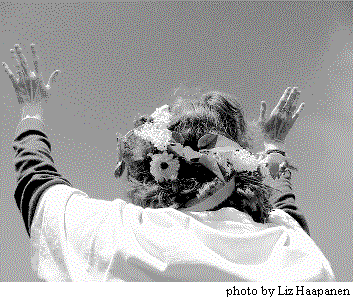
EIGHT GREAT DAYS
Sharon Folsom
Astrological observation and cycles of natural events were the basis
of calendars all over the world. The Egyptians based theirs on various
events from the flood time of the Nile to the appearance of certain stars.
However, the Roman calendar, upon which ours is loosely based, was not
highly accurate. When July eventually shifted to wintertime, a new calendar
had to be adopted in Europe. We now know that the ancients observed and
worked with astrological events very carefully--planning crop rotations,
sacred times, social festivals, etc. Calendars developed independently
in all cultures. The ancient Indo-European calendar of northern India was
very accurate. The Chinese developed a very sophisticated calendar from
the earliest mythical times, as did the Meso-Americans and Polynesians.
The Celts and the northern Europeans built standing stone structures related
to astrologically events at Stonehenge and the Avebury Circle.
These early people's seasons of celebration and work were
based on nature and the movements of the moon, sun and certain stars. Many
people still observe what are called the Great Days. The pivotal turning
points of the year in Ireland are Beltane (May 1) and Samhain (October
31). These were the two main days that separated the year into its warm
and cold halves.
Samhain was the new year, the time of the ancestors, the
day of the dead. At that time, all the cattle were brought down from the
pastures before the heavy frost and snow. They were brought to "ballies"--the
home farms of individual clan groups. "Bally" (Gaelic: bhallie)
means "winter home." The Celts were cattle people, like the West Africans.
If you've seen pictures of the Masai with their roundhouses and cattle,
in many ways that is a good picture of the Gaelic people for thousands
of years.
The Celts believed in a spiral of life--not linear time.
At Samhain, everything goes back to the point of origination; everything
disintegrates and is reordered from that beginning point. In the ancient
ritual, the fires were all darkened and then relit again. Even today, this
is the time that to remember the dead. In the dark house, the ancestors
were fed. This is why little children come to receive food--candies, sweetness--at
Halloween. The people believed that the ancestors returned as the children--who
as gifts from the realm of the ancestors, could benefit the living.
In the movie "Amistad," one of the blacks who is fighting
for his freedom gives a speech about his ancestors. He states that his
ancestors will hear him because he is their living representative--their
reason for having existed. His attitude toward them speaks for all indigenous
people. So, at Samhain, you go back to the beginning, back to the ancestors;
you invite them home, you feed them as they have benefited, nourished and
fed you in the past. They bless you and then they return to their place.
The circle of love does not break. The next day is the beginning of the
winter half of the year. The Christians made this time the Feast of All
Saints and all souls.
At Beltane, in May, there was a ceremony in which a great
bon-fire was built. Anything that people needed to get rid of, symbolically
or in reality, was put into that fire and purged. Then they would part
the fire and drive the cattle through it. The people would then leap through
the fire. The children and elders were carried, if necessary, so everybody
was included. Passing through the fire symbolized rebirth. After Beltane,
the cattle went back up to the high ground, to the "boolie" areas--the summer
pastures. No permanent homes were built there. People made tents and booths
out of foliage. Young people would take care of the cattle all summer,
and hang out together; then they would come back at Samhain.
These two great days divided the year in half; those that
divided it into quarters were midsummer's day and midwinter's day. Four
other days completed the division of the year into its mid-quarters. Eight
was the number of perfection. These eight days made up the wheel of the
year on the spiral path of natural time, and reflected the constant change
and flow of seasonal rhythms.
Ann Card, Kelseyville

This last September, when I returned from a trip to England, I felt a push
to do a gathering for women. This led to a decision to hold celebrations
at the solstices, equinoxes and their mid-points--the eight seasonal points
of light, using the Wiccan traditions to bring back the ancient knowledge.
Our first meeting was attended by thirty people. At our
fifth, a Beltane, May Day celebration, we had fifty. I could easily have
invited many more people, but I feel that small gatherings in various locations
around the county are most beneficial. With too many people, the energy
might scatter.
One thing that has struck me about this time as compared
with even five years ago is that women are much freer. Many women work
all day, and when they want some time off, they take it. The objective
is to empower women, not to overpower anyone but to bring balance. I believe
this also helps men in a very positive way.

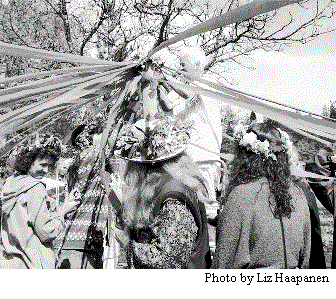
The Maypole and the fire cleansing are
recommended for Beltane, the May
Day. When we arrived each woman made a flower garland for her head. In
our ceremony, we honored the four directions, participated in a guided
meditation, hung tokens on a special tree to honor the god/goddess, jumped
over a small fire and did a Maypole dance. The pole represents the male
principle that integrates with the female ribbons that wind around the
pole--the yin/yang.
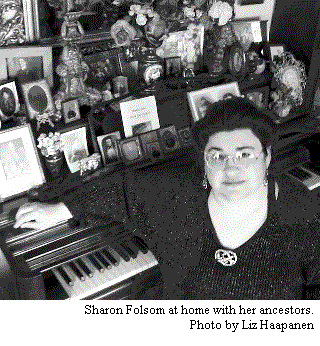
SHARON
FOLSOM, a self-defined Pagan and Mother Earth worshipper for thirty-five
years, is a charter member of the Covenant of the Goddess (COG), which
gives clerical rites to Pagans and Pagan groups--to perform marriages,
comfort the dying, bury their dead, enter prisons, etc. This worldwide
religious organization is part of the World council of Churches. Also a
harpist, she founded the Gaelic historical music group, Sheila-na-gig--created
with a grant from the DeYoung Museum Association when the Irish Art Treasures
were brought to the United States. She co-authored a book by R.A. Macavoy,
called The Book of Kells, published by Bantam Books, and has been
investigating the feminine shamanic traditions within Tibetan Buddhism
known as the Mother Tantras. Sharon works as a nurse in Fort Bragg.

Cerridwen Fallingstar
My approach to magic and ritual is Celtic/European in its base, but
I am very much an eclectic "whatever works" kind of person. As one of my
friends once said, "I practice magic exactly the way my ancestors did 60,000
years ago; I make it up." In that way, I'm very traditional. Magic is about
learning to let go and move with the energy of the moment.
The word "Wicca" comes from the same root word as "wicker"--from
willow--which is about moving and bending with the wind. It's about fluidity.
Beginners tend to be nervous and want to do everything exactly right. I've
also noticed that when people are into so-called "high magic", where everything
has to be just so, nothing happens. There's no energy; it's all form, and
no essence. Some people who have practiced Paganism for a very longtime
still operate out of their egos and their heads. When a practice is done
in a rigid way, it loses its power.
I live in America, a country that has brought people from
all races and geographies together. Why practice strict Celtic religion
here? That's not what the ancestors in America were doing. Where I live,
the native ancestors were the Miwok. What were they doing? We don't know
much about them, since their tradition was thoroughly wiped out by smallpox
when the Spanish came. It's natural to integrate different traditions when
you live in an area that is a racial, genetic and cultural hodge-podge.
It also makes sense to adapt your practices as consciousness changes.

One of the benefits of our tradition having been so completely broken
is that it frees us up to explore what works. Through our trial-and-error
process we learn why things were done in certain ways in the past. Most
people practicing Paganism now have an entirely different consciousness
than people did hundreds or thousands of years ago. Most of us are highly
educated, and approach ritual from a very psychological perspective. We
can consciously adapt old ways to our current needs. That is not to say
we avoid doing anything traditional--we just don't do it blindly.
For instance, take the Jewish and Moslem tradition of
circumcision. People have hung onto this practice but now we are asking,
"What's the point?" For desert people, with very little opportunity to
wash, it might make sense. The Jewish tradition says it was designed to
make men less sexually sensitive, to try to keep them more faithful. Fifty
percent of the nerve endings of the penis are in the foreskin. We may ask
ourselves, do we still want to keep a tradition that damages people's sexuality?
Does that fit with our beliefs today?
We have to try to understand tradition and ritual in the
context of their practice. If we go back far enough in our tradition, we
may find people did human sacrifice, but no modern European based Pagans
even do animal sacrifice anymore. People did sacrifices because this opened
the gate between the worlds. When something dies, the gate is opened for
that soul to pass. This became suddenly clear to me when I was in Hawaii
visiting places where sacrifice was done relatively recently. I had a vision
of what they were trying to do. The person being sacrificed was not afraid
of death and didn't see death as a huge divide--just as we don't make a
big deal about going to sleep or make a drastic division between the sleeping
and waking states. Although a lot of power came from the sacrifice, once
you started sacrificing people who were unwilling or afraid, the energy
became very, dark and evil.
To kill an animal while respecting and honoring it a being--as
a soul--is far more humane and enlightened than killing an animal using
the factory farming practiced in modern times. Most animals killed in our
culture release a lot of adrenaline into their bodies. The animal's fear
changes the quality of the meat, and effects us differently in our bodies--this
in addition to the fact that the meat is also being poisoned by the chemicals
and hormones that are injected into animals.

I have a Pagan-Wiccan group called "Earth Rite" which practices public
rituals at the solar Sabbats. Between forty and a hundred people attend
these. We don't advertise; it's all word-of-mouth. If we advertised, we
would be deluged, and the rituals would start to lose intimacy.
I travel and teach workshops and lead tours to sacred
sites. My year-long apprenticeship program is limited to fifteen people--a
small, coven-sized group. By providing this intimate environment, trust
can be established and people can connect deeply enough with each other
to take risks and go into altered states. We never use any drugs. We use
more controlled means--breath and trance work and other techniques for moving
in and out of different dimensions. A person can read a lot of books, but
if you work with a teacher you trust and respect, that's the best way.
You don't have to learn everything by trial and error, which is basically
how I learned everything. . .
That's a harder road.
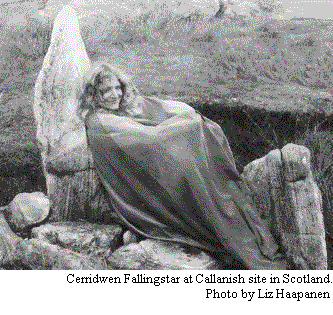
 Barbara Willens, Willits
Barbara Willens, Willits
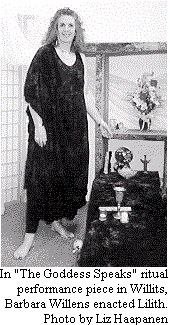 Ceremonies
are very important for bringing the sacred back into our lives. If we let
a significant event pass by without some form of recognition, then life
becomes a meaningless succession of days. But if we stop and take time
to honor the important events in our lives--birthdays, moving into a new
home, starting a new job, children moving out of the home, a young girl's
first menstruation, or the ending of menses--then our lives become more
enriched and we appreciate our life cycles as sacred and holy. Ritual acts
as a bridge linking the spiritual with the physical world.
Ceremonies
are very important for bringing the sacred back into our lives. If we let
a significant event pass by without some form of recognition, then life
becomes a meaningless succession of days. But if we stop and take time
to honor the important events in our lives--birthdays, moving into a new
home, starting a new job, children moving out of the home, a young girl's
first menstruation, or the ending of menses--then our lives become more
enriched and we appreciate our life cycles as sacred and holy. Ritual acts
as a bridge linking the spiritual with the physical world.
In bringing our awareness out of the everyday, ritual
transports us between the worlds to focus our intention. Intention is important
to move energy and create what you want. The following step-by-step format
works well for a small, quiet, focused group. With a larger group following
such a format may not be possible or desirable. A good ceremonialist or
facilitator is open to the feelings and the energy of the circle and will
pay attention to timing and transitions from one phase to the next. Information
comes from attuning to the needs and receptivity of the group.
1) The Altar
The altar is the center of the circle, the focal point of any ceremony.
It can be as simple as lighting one candle as a focus to open the consciousness
for going between the worlds. The altar creates a distance from the everyday
as you begin to move into the sacred space. It can be elaborated in special
ways to beautify and add personal significance. I might place a beautiful
cloth underneath my altar, add pictures of my children or ancestors, fresh
flowers, a special stone, or anything else that is meaningful to me. It
doesn't need to be ornate.
Next I establish the directions of the four elements.
I use elements that are somewhat different than those used in Native American
tradition. It doesn't matter what system you follow, as long as you are
clear and comfortable with your intention.
In the east, the direction of air and intuition, I might
place a feather to represent the winged ones, or incense that also goes
into the air. The south is the element of fire. I usually have a red candle
there, or something that has been forged in fire--a metal or clay goddess.
This is the direction of the passions, which provide the energy to do the
work. I may use a seashell or a bowl of water with oils to represent the
west, which is the element of water. The north is the element earth. There
I place a crystal or a little bowl of earth or salt. As this is the place
of the wisdom of the ancestors, you could also have a picture of an ancestor
there. The center is the Great Spirit, the great mystery that is the container
for all of the elements.
As I create the altar, I begin to go into an altered state.
As I place the pieces on the altar, I start to slow down and focus on present
time.
2) Smudging
Smudging helps set the mood. It cleans the air and acts as a purifier.
The scent helps me get in touch with my body, clear my mind and become
present. Sage works well for a general ritual and is easy to obtain. I
smudge the altar, myself and each person. I may put the sage in a special
bowl, or on a charcoal disk, or use smudge sticks. For my classes, we have
made blessing feathers with a leather handle to brush the smoke around
each person. You can use something elaborate, a single feather or even
your bare hands to cleanse and comb the aura.
3) Invitation of the Elements through the Four Directions
I ask people within the circle to call in the four directions, beginning
with the east. This can be done through an invocation, song, prayer or
simple statement. The elements of life and their associations--earth (north/wisdom,
knowledge, being grounded), air (east/intelligence and inspiration), fire
(south/passion and energy) and water (west/emotions, moods, healing)--support
the ceremony by bringing their energies into the circle. The center of
the circle represents the power to transform.
4) Casting the Circle
I walk around the circumference of the circle with a wand or branch
and say, "With this wand, I cast the circle for love, support and trust.
May all of our words and actions be for the highest good of all, harming
none." This statement creates a sacred circle that is safe and protected,
within which the energy is contained and focused. If casting the circle
in this way is not possible, due to a large number of people being present,
then stating the intention out loud can suffice. There are also ways to
cast the circle physically by placing stones or salt around the perimeter.
5) The Invocation
The invocation describes the reason or focus for the ritual. For instance,
"We gather here today to honor (person's name), who is turning fifty years
old. In ancient times, it was the elder women who were called upon to make
decisions for the welfare of the tribe. In ancient Greece, the Oracles
of Delphi were the mid-life women." Or, "We gather here today to celebrate
the return of the light at the winter solstice."
6) The Body of the Ritual
We are contained within the circle and can now follow through with
our purpose. Everyone is involved in and is validated by the ritual. The
body of the ritual contains elements of healing, change and transformation.
7) Raising the Cone of Power
This can be done through a song, drumming, a dance, or any form that
lifts and releases the energy. I lead people in a visual experience at
this point with some statement like, "Now, imagine all of our prayers taking
form, swirling around and being sent out into the universe" or, "May the
universe support (name) in her transition in turning fifty."
8) Grounding
As we let go of the energy and send it to the sky and stars, we bring
residual energy down through the body and ground it back to Mother Earth,
who supports our whole being.
9) Send the Directions Back
I thank the directions for joining in our circle and offering their
guidance, wisdom, and energy to fulfill our dreams. We send them on their
way and thank them.
10) Song or Saying
End with a song or saying.
11) Open up the Circle
If you go deeply into a ritual, you may have one between the worlds
and find yourself in a kind of trance, or feel light-headed. Opening the
circle brings you back to the everyday world. This is an appropriate time
to share food and drink as this helps bring people back into their bodies.
I feel fortunate to be living in a Willits community that
offers so many possibilities for growth and insight and belonging. It is
heartening to know that on the full moon, new moon, solstices and equinoxes,
women and men gather in circles countywide in celebration support.
Barbara offers classes on creating sacred ceremonies and celebrating
the eight holy days of the year--the solstices, equinoxes and the mid-points.
As a ceremonialist she helps facilitate rites of passage in Mendocino and
Sonoma counties, and continues to participate in full and new moon groups.

Ann Maglinte
The moon and her cycles deeply affect us and are rooted in the psychic
patterns of our lives. Rituals to mark the moon's phases and the changing
seasons nourish our heart and soul and help us understand how the cycles
affect our moods, our energy level and our bodily rhythms. By setting our
intention with the phases of the moon, we can harmonize with the natural
cycles of change.
The stories and myths of the Goddess connect all women
together and symbolize our own stories. They remind us that we are valuable,
creative and powerful women. We are all the embodiment of the Goddess.
During the time of new-moon energy you might think of
Artemis (Greece) and look toher for guidance. She and Diana (Rome) are
maiden goddesses, protectors of the forest,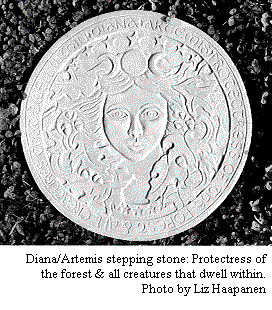 wild places and wild creatures. The new moon is the time of beginnings,
the time to talk about dreams--what you are hoping for at the beginning
of the month. She is the young woman, the adolescent and daughter, the
one whose dreams are without limit. Athena (Greece), goddess of wisdom,
freedom and women's rights, is also associated with the new moon. She is
also the goddess of handicrafts and peace.
wild places and wild creatures. The new moon is the time of beginnings,
the time to talk about dreams--what you are hoping for at the beginning
of the month. She is the young woman, the adolescent and daughter, the
one whose dreams are without limit. Athena (Greece), goddess of wisdom,
freedom and women's rights, is also associated with the new moon. She is
also the goddess of handicrafts and peace.
The full moon represents full power, abundance, and shared
ideas. This is the time to get dreams going--a time for creativity and manifestation.
She symbolizes motherhood and nourishment, and is akin to the Tarot card
"The Empress," the mother and creative force. She represents fullness.
Demeter (Greece), Isis (Egypt), Selene (Greece), Luna (Rome) and Kuan Yin
(Asia) are all associated with the full moon.
 The dark of the moon is the time to release and let go of the things that
no longer serve us. It is a symbol of regeneration. Ceremonial circles
help people in this process by giving them an opportunity to share what
they want to release. This can be done verbally or perhaps by writing a
list on a piece of paper and burning it in a candle. Doing a quiet meditation
by yourself is valuable, but when you actually speak your intention to
others, it becomes more powerful and real.
The dark of the moon is the time to release and let go of the things that
no longer serve us. It is a symbol of regeneration. Ceremonial circles
help people in this process by giving them an opportunity to share what
they want to release. This can be done verbally or perhaps by writing a
list on a piece of paper and burning it in a candle. Doing a quiet meditation
by yourself is valuable, but when you actually speak your intention to
others, it becomes more powerful and real.
The dark of the moon is a time for looking at the inner
side of ourselves--the side we don't always want to pay attention to. Read
myths about Hecate (Greece), Cerridwen (Wales), Persephone (Greece) or
Kali (India) to bring yourself more in touch with this phase of the lunar
cycle. They have the power to give life and to take it away. They are goddesses
of the spirit world and of regeneration, the grandmother crones, the goddesses
who no longer bleed. As woman of wholeness, they know the wisdom of life
and death. Kali, the destroyer, is the dark and terrifying aspect of the
goddess, who beheads the demon Ignorance.
Our Willits women's group used to meet monthly on the
full moon. For the past year, we have been focusing more on our inner selves
and our dreams, so we get together during the new moon--indoors at someone's
house or outside if weather permits. Our circle is not closed. Anyone can
invite a friend, and we welcome women who would like to share with us.
Generally one person organizes the upcoming get-together. We have a specific
focus with several parts to the meeting, and women take spontaneous turns
in participating in what they enjoy leading or sharing--a guided visualization,
singing, chanting, or a bit of knowledge. We often do some type of divination,
giving each participant an opportunity to draw a card or stone depending
on the divination tool, and then talk about it. We have used such tools
as Medicine cards, Amulets of the Goddess, Mah Jong tiles (at Chinese New
Year) and Nordic runes. When focusing on runes, we brought information
about them, and then each person made her own set and fired them.

Ever since I was young, I have drawn pictures of women. In college
I did a lot of drawing in the Art Nouveau style--beautiful women with long,
flowing hair. Many were Greek images. Now that I look back, I see that
they were goddesses. I have found that the Native American, Celtic, Norse,
Asian and other cultures shared the same universal archetypes of the feminine.
For example Artemis (Greece) and Diana (Rome) are similar; Kali (India)
and Hecate (Greece) are also very similar in what they represent.
I enjoy researching goddesses for the plaques I make. For example,
Athena, the goddess of the air is also the goddess of wisdom. She is associated
with communication, intuition, and the direction, east. As I get to know
each goddess, I ask certain questions. Is she a maiden, mother or crone
aspect? Which direction and element is she associated with? What animals
are her totems? What does she inspire? I inscribe this information on the
plaques I make, hoping to inspire women to remember their own goddess-self
as they look at them.
I have been making goddess plaques for about five years
and am focusing on outdoor pieces now --incorporating both goddess and Celtic
designs in plaques, stepping stones and outdoor fountains using serene
forms to create beauty, suggest relaxation, and help one attune with the
elements.
This is a shared process. I research and make the original
design in clay, a process that takes several weeks; my husband makes the
molds and casts the pieces in a concrete material called hydrostone; then
I add finishing touches with paint to bring out the details. Some people
feel our stepping stones are too pretty to walk on, but they actually look
better when soil gets into the indentations and inscriptions.
Around the rim of the stepping stone/plaques I inscribe
sayings about love, joy, abundance, and friendship. The Sun plaque inscription
is, "Friends are like sunshine in the garden of life." The full moon stepping
stone says, "May the moon shine upon you, may love surround you and pure
light be within you."
As friends visit the homes and gardens where the plaques
and stepping stones have been placed, and read these messages, the good
feelings and positive energy we put into them spirals out.